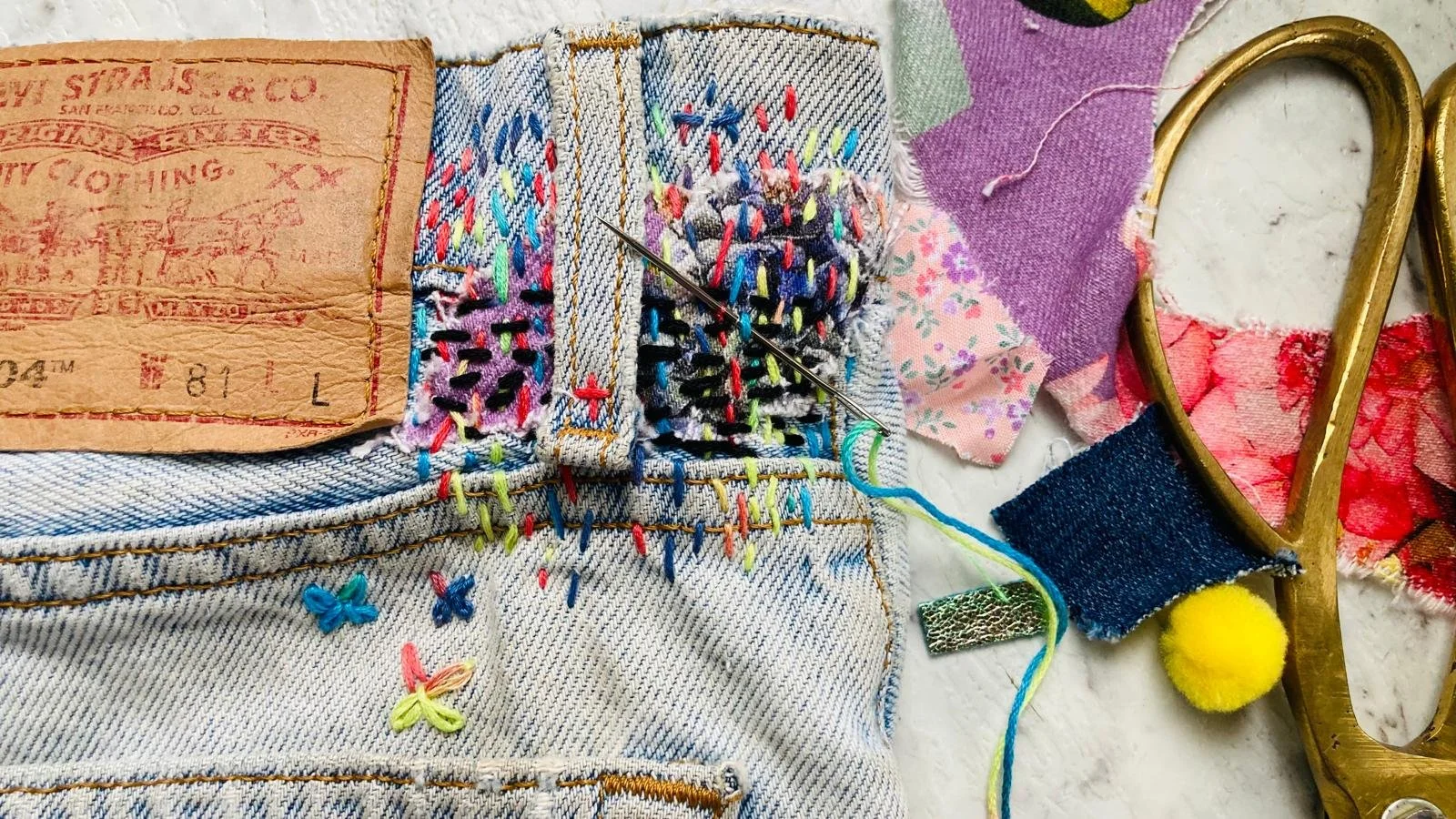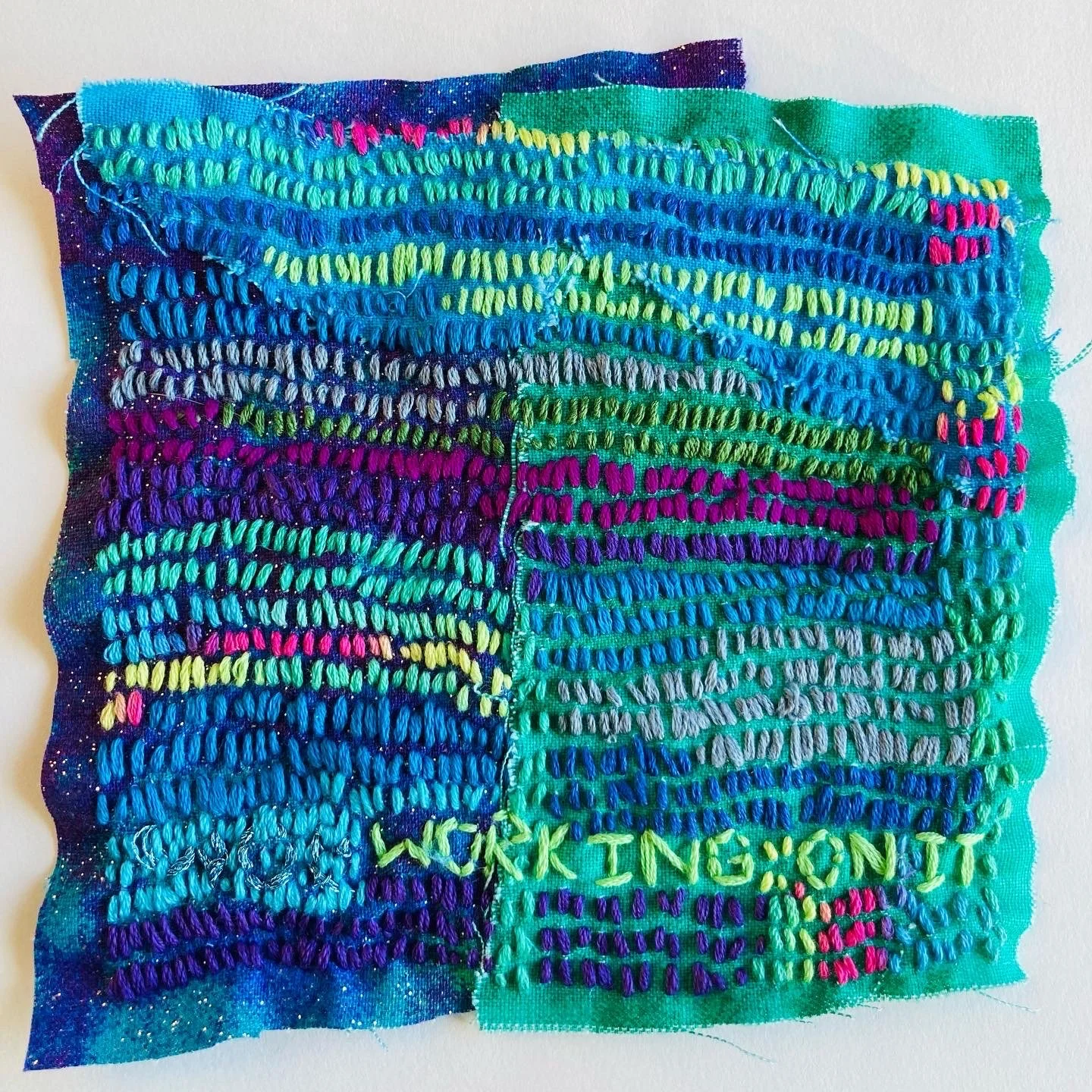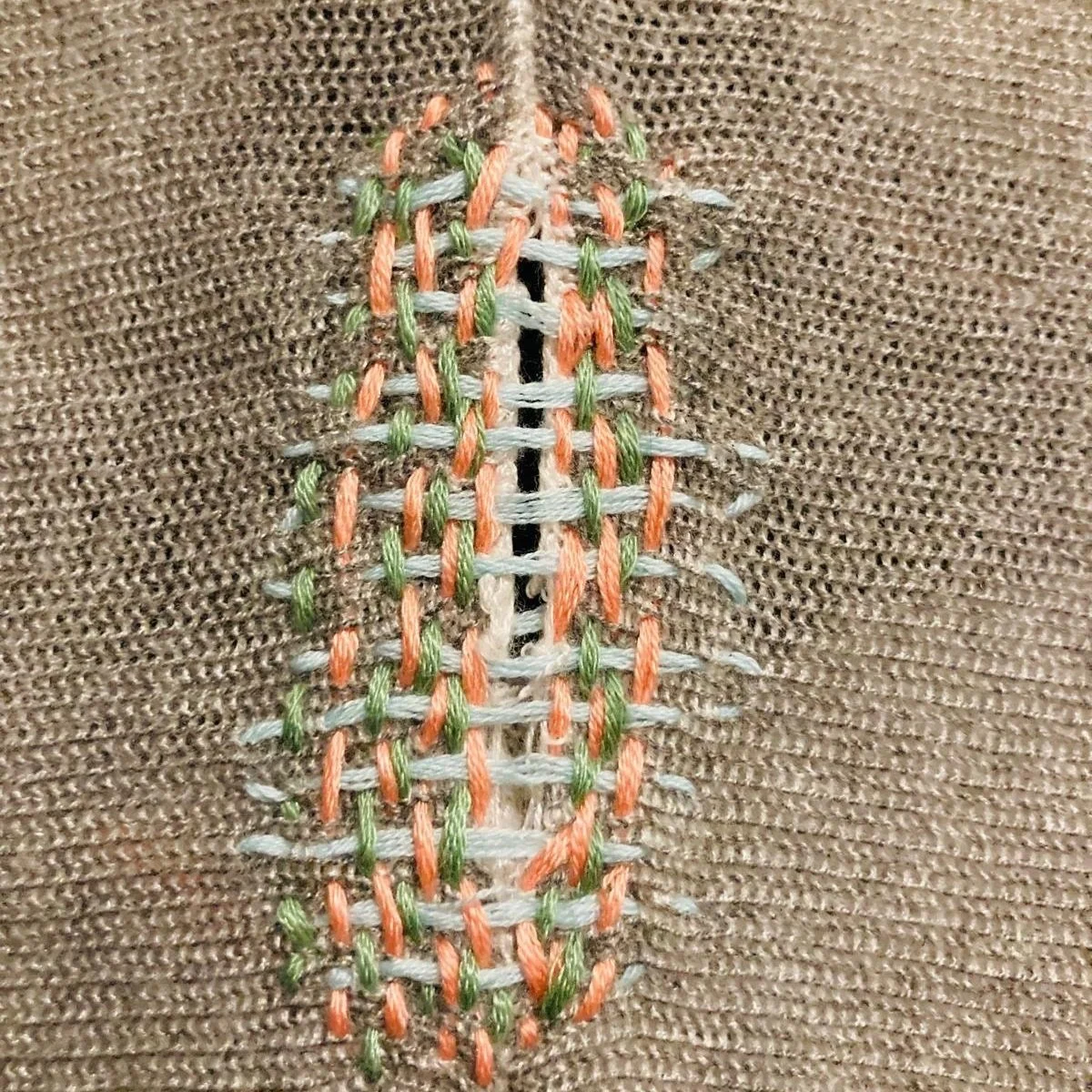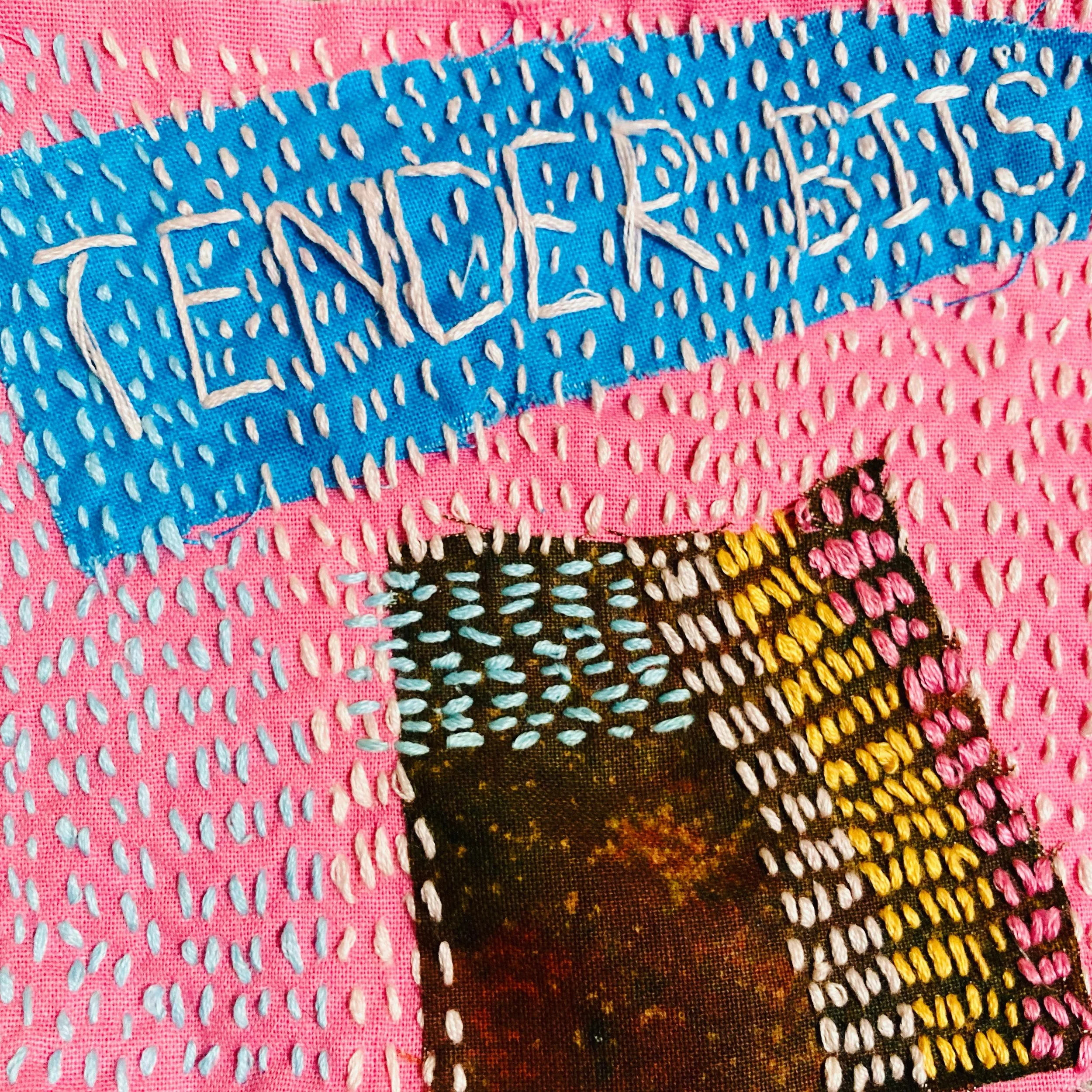Visible Mending: tending through mending
There’s something quietly powerful about taking the time to mend what’s been damaged through wear and tear.
We are living in a world that is often pushing us toward fast fashion, disposable and replaceable items. Visible mending invites us to push back on the instant gratification of replacing what seems to be ‘damaged’ and ask us to slow down and take care—for our clothes, our planet, and ourselves in a skillful and sustainable way. Rather than hiding the signs of wear and tear, this practice makes repair visible, personal, and even beautiful.
What Is Visible Mending?
Visible mending is the art of repairing clothes in a way that celebrates the flaw rather than disguising it. Using simple hand-stitching techniques—like running stitch, lazy daisy, French knots, or patching—you can transform a hole or worn spot into something new and expressive.
The stitches don’t need to be perfect. That’s not the point.
It’s about process, presence, and connection.
A Tradition Rooted in repair and sustainability
Visible mending draws inspiration from traditional Japanese practices like Boro and Sashiko.
Boro comes from the Japanese word for "rags" and refers to the practice of layering and stitching fabric to extend the life of garments, especially in farming communities.
Sashiko, meaning “little stabs,” is a form of decorative reinforcement stitching. It often features repeating patterns and was originally used to strengthen fabric.
Both practices are rich with history—and heart. They speak to a time when cloth was precious and care was stitched into everyday life.
Right: Image of artwork by Mary-Helen Daly, Working on it, Textile using boro style stitching a visible mending techniques.
Material list:
Embroidery Needle
Thread or embroidery floss
Scissors
Fabric scraps for patches
Pins or clips
Thimble (optional)
Embroidery hoop (optional)
Fabric marker or chalk (optional)
Basic stitching techniques
There is no one way of repair, instead the invitation is to apply your own creative flair to your unique repair. Below are some basic tecniques you could use to repair textiles.
Hand-Stitching Techniques:
Running Stitch – A simple straight stitch, great for outlines and patterns.
Seed Stitch – Small, scattered stitches to add texture or fill space.
French Knot – A decorative knot for detail and raised texture.
Patching – Layering fabric and using visible stitches to repair and decorate.
Lazy Daisy – A looped stitch often used to create petal or leaf shapes.
Left: Image of Lazy Daisy used for Visible Mending.
Photo & artwork credit: Mary-Helen Daly
Other techniques
Darning is a sewing technique used to repair holes or worn areas in fabric, especially in items like socks, jumpers, and jeans. It involves weaving new threads over the damaged area to reinforce or recreate the fabric's structure.
Purpose: To mend fabric rather than replace it.
Tools: Typically a needle, thread or yarn, and often a darning mushroom or egg (a rounded tool placed under the fabric to provide tension and shape while sewing).
Method:
Stitch parallel threads across the hole.
Then weave threads in the opposite direction, over and under the first set, creating a woven patch.
Types: Invisible, Decorative and Swiss.
Example of decorative darning used to repair hole in jumper by Mary-Helen
While some of these techniques may look complicated, they are relativley simple techniques to grasp. My hope is that they’ll give you the confidence and inspiration to begin—and permission to play, explore and develop your own style. You can see all of the methods mention above demonstrated in the video below.
Follow along at your own pace:
Why Mend?
Mending helps us to our senses, presence, creativity and values. It lets us:
Extend the life of the things we love and feel skillful in being able to restore those items.
Express ourselves through texture, colour and form. And tap into our own uniqueness and showing rather than telling what you care about.
Practice sustainability in a tactile, meaningful way. It can also cultivates a mindset of being more conscious and particular of what you welcome into your life and what impact it has on our world.
Pause and reflect while our hands are busy our mind can settle and focus. Insights come when body and mind are engaged in sensory experiences.
It’s a small act, but a deeply symbolic one. Each stitch says: this is worth saving, this is worth taking time to tend to.
Left: Example of visible mending using boro stitching by Mary-Helen Daly
The deeper aspect: healing the wounds we can’t see
This practice also invites reflection on the wounds we all carry particulary the invisible ones.
The ones we can’t quite reach, or that aren’t easy to repair; that take a lifetime to mend, and perhaps even longer.
The generational wounds passed down to us — the ones we may not even be conscious of.
The scars that others see, noted as an imperfection rather than marking a moment in time, a story waiting to be told.
Wounds require tending in a delicate, gentle way.
They take time to heal — to scab, flake, shift in colour, and fade.
They itch, tingle, and bleed.
And rather than wishing them away, what if we tended to them like a garden — patiently and gently, as many times as needed — waiting for them to slowly soften and be stored in long-term memory?
Recently, I was diagnosed with skin cancer on my nose. Because of its tricky placement, surgery was required to remove it.
I knew it would leave a prominent scar and changes to my appearance — which is part of why I wanted to run this workshop:
To honour all the wounds and scars we carry. The ones that are known, and the ones that remain unseen or unknown.
To make space for them — through the act of visible mending.
Our scars are not something to be ashamed of.
They are signs of our fragility, survival, and recovery.
They hold stories, memories, and threads of connection to the life we’ve lived.
Final thoughts
Visible mending is more than a way to fix what’s been damaged — it’s a quiet act of care, of choosing to tend to what we might otherwise discard. And I body feels every stitch we make towards repair. When done intentionally, the practice can become a story, a mark of presence, a declaration that something still matters.
In a world that often pushes us to hide our flaws or replace what’s worn and aged, visible mending offers another way: to honour the history of an object — or a life — by working with it, not against it. To make beauty from imperfection and celebrate the signs of wear. To embrace the patchwork nature of being human.
In mending our clothes, we are also mending something in ourselves — slowly, thoughtfully, and tenderly.
About me
Hi, I’m Mary-Helen — a Transpersonal Art Therapist and creative companion for those ready to reclaim joy through self-expression. I offer gentle, one-to-one online art therapy sessions for women who feel disconnected, stuck, or unsure what’s next.
These sessions are not about being good at art — they’re an invitation to explore your inner world through colour, image, and metaphor. We work together to meet the parts of you that may have been silenced, scattered, or hidden, and give them space to be seen, heard, and integrated.
Whether you’re navigating a life change, longing for clarity, or simply seeking space to breathe and reconnect, this creative process can help you soften, reimagine, and reshape your story — one mark at a time. Find out more about 1:1 Art Therapy sessions here.






